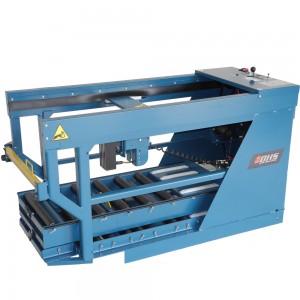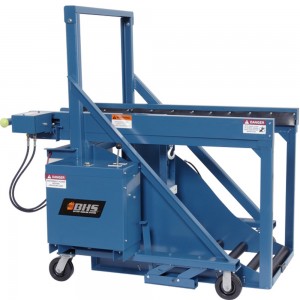We use cookies to make your experience better. To comply with the new e-Privacy directive, we need to ask for your consent to set the cookies. Learn more.
Choosing Between Powered and Manual Battery Handling Equipment
For large forklift fleets in fast-paced environments, powered battery handling equipment offers clear advantages over manual equipment, and more powered functions typically allow for a faster, more productive fleet. However, the decision is tougher for more modest fleets. Managers of facilities that only operate several lift trucks per shift must balance many factors to determine whether powered or manual battery changing equipment will provide the greatest returns on investment.
BHS Carriage Systems
BHS Operator Aboard Battery Extractor Systems provide extensive benefits to high-capacity applications, but side-extraction fleets that change out fewer than 50 batteries per day can often achieve peak efficiency with a BHS Carriage System instead. BHS Carriage Systems are a total solution for small-to-midsized industrial battery rooms.
Battery Transfer Carriages with a variety of manual or powered systems complete change-outs quickly and safely. Note that even manual systems provide powerful assistance; every model of BHS Battery Carts and Carriages shares a strong ergonomic benefit.
These factors include:
- Number of battery changes per day.
- Upfront equipment costs.
- Lifetime maintenance and upkeep costs.
- Size, weight, and handling requirements of forklift batteries.
- Pallet truck availability.
- Staff Availability.
- Projected operational growth.
Depending on the specifics of these and other conditions, battery room operators may achieve greater benefits from equipment that is fully manual, fully powered, or some combination of the two.
This article will explore the advantages of manual and powered systems within battery handling machines. Detailed consideration of the battery change-out process will also help guide managers to a battery handling system that matches the fleet exactly, creating the most efficient battery room possible.
Powered and Manual Functions of Forklift Battery Changers
In their simplest form, side-extraction battery changers basically accomplish three tasks: they pull batteries out of forklift battery compartments, transfer batteries to charging stands, and deposit batteries in stands. Then they reverse the process. Changing a forklift battery involves five discrete motions, each of which can be accomplished by a powered or a manual system.
-
Battery transfer carriages move vertically to access battery compartments in a variety of lift trucks. Vertical travel also allows battery changers to reach the differing heights of roller stands and wash cabinets.
A 12-volt power unit and a hydraulic cylinder provide this lift function on powered models. On manual battery carriages, a center-mounted hand jack enables vertical ajustment. Several models of BHS Battery Carriages mount to an existing pallet truck, which provides its own lift power.
-
The extractor arm attaches to the battery. The manual option is a hook-and-chain, while powered extractors use either vacuum or magnetic grips.
-
The extractor arm moves into the carriage, pulling the battery into place for transfer. Hydraulic power makes this process as simple as pressing a button, and manual options include a hand-wheel or a simple winch.
-
Once the battery is safely secured in the carriage, the carriage travels across the floor, transporting the battery to a roller stand for charging or maintenance tasks. Manual floor travel simply requires pushing the carriage via heavy duty phenolic casters.
BHS Automatic Transfer Carriages (ATC) and Walkie Transfer Carriages (WTC) derive travel power from an existing pallet truck. A third option, the BHS Mobile Battery Extractor (MBE), is pre-mounted to a pallet truck with a 24 volt DC powerhead, providing electric travel assistance.
-
Finally, the extractor arm, powered by the same system that controls extraction, pushes the battery onto a battery stand. Replacing a battery in the lift truck’s compartment is a simple reversal of this process.

Figure 1. The BHS Automatic Transfer Carriage (ATC) mounts to an existing pallet truck, providing powered battery extraction.
Which Forklift Battery Changing Systems Should Be Powered?
Benefits of powered mechanisms within battery carriages include faster battery changes, simpler operation for staff, and better ergonomics. The fully powered BHS Mobile Battery Extractor nearly rivals the efficiency of the elite Operator Aboard Battery Extractors (BE), completing battery swaps in only 3-5 minutes (BHS BE systems change batteries in 2-3 minutes under optimal conditions).

Figure 2. BHS Battery Transfer Carriages (BTC) incorporate any combination of powered and manual operation.
Fully manual Battery Transfer Carriages (BTC) are also extremely efficient — they provide quick change-outs of only 5-8 minutes. Operations that require fewer than six battery changes per day can generally spare the time, and will benefit from the energy savings of a fully manual battery changer.
In addition to these two models, BHS offers a BTC with every combination of powered and manual functionality. This versatility allows operation managers to build custom solutions for their specific battery handling needs.
For instance, facilities that do not employ battery room staff often rely on forklift operators to complete battery changes themselves. For these operations, a fully powered BTC will provide the quickest battery changes, allowing lift trucks to spend more time on revenue-generating material handling tasks.
Matching Battery Transfer Carriages to Fleet Requirements
Choosing battery transfer equipment that matches the battery room is similar to “right-sizing” a fleet. A perfectly right-sized battery fleet consists of exactly the number of batteries forklifts need to operate effectively during each shift. An excessive stock of forklift batteries can be expensive due to the wasted costs of purchasing, storing and maintaining the extra units. On the other hand, if the collection is too small, operators overuse batteries, which substantially reduces the operating life of each unit.
According to trade publication Modern Materials Handling, the process of right-sizing battery fleets can result in savings of up to $100,000 per year for some operations. We can reasonably conclude that facilities can see similar benefits by choosing an appropriate combination of powered and manual battery changers. Profitability is directly tied to efficiency, and the right battery room equipment makes a difference.
In the book Warehouse Management: A Complete Guide to Improving Efficiency and Minimizing Costs in the Modern Warehouse, author Gwynne Richards lists the following considerations to balance when choosing material handling equipment:
- Cost
- Speed
- Floor-Space Conservation
- Injury Prevention
- Energy Consumption
The following table shows which type of system is more likely to provide the greater benefit in each of these categories. Remember that the details of individual circumstances differ, and this information is for general reference only.
| Beneficial Factors | Powered Systems | Manual Systems | Both/Either |
| Lower Cost | X | ||
| Higher Speed | X | ||
| Floor-Space Use | X | ||
| Safety Benefits | X | ||
| Lower Energy Consumption | X |
Figure 3. This comparison shows the likely advantages of powered vs. manual operation in five important categories.
Ergonomic Considerations for Forklift Battery Changers
Every BHS Battery Transfer Carriage model provides essential ergonomic benefits, and ergonomics is certainly an important factor for long-term profitability. These battery changers also help facilities comply fully with 29 CFR 1910.178(g)(4), an OSHA standard which requires employers to provide adequate battery handling equipment. Both powered and manual units help to protect workers when matched with appropriate applications.
While manually powered battery changers protect workers from strains and musculoskeletal disorders associated with lifting, pushing, and pulling, they also require more hand motion from workers than their powered equivalents. Even non-strenuous activity in small muscles can create a repetitive motion injury, which are quite common in many fields. In fact, the 2014 Liberty Mutual Workplace Safety Index ranked repetitive motions ninth in their ranking of workplace injury sources, with a total cost to U.S. companies of 1.84 billion dollars in that year.
To avoid the risk of repetitive motion injuries, facilities that require steady battery changes throughout a single battery room operator’s shift should opt for powered equipment whenever possible. The wheels and jacks that power manual motion on BHS Battery Carriages are easy to operate, but any small motion repeated for hours on end poses an ergonomic risk — powered equipment reduces that risk considerably.
Scalable Battery Handling Systems Deliver the Best Combination of Benefits
If the choice between powered and manual battery handling equipment had to be simplified to a single rule, it would be something like this: the more battery changes each shift requires, the more powered systems managers should look for in their forklift battery changers.
Manual mechanisms have many advantages. They do not consume energy, their maintenance requirements are simple, and they usually have a lower initial cost. However, as warehousing operations grow, more batteries must be changed at a faster pace. At some point along the way, the benefits of manual battery changers will fall behind the efficiency gains of powered battery extractors.
BHS Carriage Systems are highly scalable and can grow to match an expanding operation. Facility managers can replace manual systems with powered equipment as the battery collection builds, and BHS Single Level System Stands can be custom built to meet any specification. No matter what combination of powered and manual operation best matches a battery room’s requirements, BHS Carriage Systems provide significant productivity increases for forklift fleets of any size.
References:
Chao, Elaine and John Henshaw. “Materials Handling and Storage.” Occupational Safety & Health Administration. United States Department of Labor, n.d. Web. 12 Aug 2015.
Kaletta, James. “Lift Trucks: Battery Room Safety Tips.” Modern Materials Handling. Peerless Media Network, 27 Oct. 2010. Web. 12 Aug 2015.
“Powered Industrial Trucks - 1910.178.” Occupational Safety & Health Administration. United States Department of Labor, 2006. Web. 12 Aug. 2015.
Richards, Gwynne. Warehouse Management : A Complete Guide To Improving Efficiency And Minimizing Costs In The Modern Warehouse. London: Kogan Page, 2011. eBook Academic Collection (EBSCOhost). Web. 12 Aug. 2015.
Smith, Sandy. “Top 10 Workplace Injuries Cost U.S. Business $1 Billion Per Week.” ehstoday. EHS Today. Penton, 7 Jan. 2015. Web. 12 Aug. 2015.
Vanasse, Harold. “Other Voices: The Impact of Right-Sizing on Battery Room Operation.” Modern Materials Handling. Peerless Media Network, 10 Apr. 2015. Web. 12 Aug. 2015.

